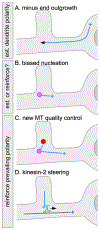Principles of microtubule polarity in linear cells
- PMID: 35016908
- PMCID: PMC10071391
- DOI: 10.1016/j.ydbio.2022.01.004
Principles of microtubule polarity in linear cells
Abstract
The microtubule cytoskeleton is critical for maintenance of long and long-lived neurons. The overlapping array of microtubules extends from the major site of synthesis in the cell body to the far reaches of axons and dendrites. New materials are transported from the cell body along these neuronal roads by motor proteins, and building blocks and information about the state of affairs in other parts of the cell are returned by motors moving in the opposite direction. As motor proteins walk only in one direction along microtubules, the combination of correct motor and correctly oriented microtubules is essential for moving cargoes in the right direction. In this review, we focus on how microtubule polarity is established and maintained in neurons. At first thought, it seems that figuring out how microtubules are organized in neurons should be simple. After all, microtubules are essentially sticks with a slow-growing minus end and faster-growing plus end, and arranging sticks within the constrained narrow tubes of axons and dendrites should be straightforward. It is therefore quite surprising how many mechanisms contribute to making sure they are arranged in the correct polarity. Some of these mechanisms operate to generate plus-end-out polarity of axons, and others control mixed or minus-end-out dendrites.
Keywords: Kinesin; Microtubule; Neuron; Polarity.
Copyright © 2022. Published by Elsevier Inc.
Figures


Similar articles
-
Dendrites In Vitro and In Vivo Contain Microtubules of Opposite Polarity and Axon Formation Correlates with Uniform Plus-End-Out Microtubule Orientation.J Neurosci. 2016 Jan 27;36(4):1071-85. doi: 10.1523/JNEUROSCI.2430-15.2016. J Neurosci. 2016. PMID: 26818498 Free PMC article.
-
Asymmetric microtubule nucleation from Golgi stacks promotes opposite microtubule polarity in axons and dendrites.Curr Biol. 2025 Mar 24;35(6):1311-1325.e4. doi: 10.1016/j.cub.2025.02.013. Epub 2025 Mar 3. Curr Biol. 2025. PMID: 40037351
-
Wnt signaling establishes the microtubule polarity in neurons through regulation of Kinesin-13.J Cell Biol. 2021 Sep 6;220(9):e202005080. doi: 10.1083/jcb.202005080. Epub 2021 Jun 17. J Cell Biol. 2021. PMID: 34137792 Free PMC article.
-
Differentiation between Oppositely Oriented Microtubules Controls Polarized Neuronal Transport.Neuron. 2017 Dec 20;96(6):1264-1271.e5. doi: 10.1016/j.neuron.2017.11.018. Epub 2017 Nov 30. Neuron. 2017. PMID: 29198755 Free PMC article. Review.
-
Polarity Sorting of Microtubules in the Axon.Trends Neurosci. 2018 Feb;41(2):77-88. doi: 10.1016/j.tins.2017.11.002. Epub 2017 Nov 30. Trends Neurosci. 2018. PMID: 29198454 Free PMC article. Review.
Cited by
-
Map-1a regulates Sertoli cell BTB dynamics through the cytoskeletal organization of microtubule and F-actin.Reprod Biol Endocrinol. 2024 Apr 3;22(1):36. doi: 10.1186/s12958-024-01204-y. Reprod Biol Endocrinol. 2024. PMID: 38570783 Free PMC article.
-
Augmin complex activity finetunes dendrite morphology through non-centrosomal microtubule nucleation in vivo.J Cell Sci. 2024 May 1;137(9):jcs261512. doi: 10.1242/jcs.261512. Epub 2024 May 10. J Cell Sci. 2024. PMID: 38587100 Free PMC article.
-
CryoET of β-amyloid and tau within postmortem Alzheimer's disease brain.Nature. 2024 Jul;631(8022):913-919. doi: 10.1038/s41586-024-07680-x. Epub 2024 Jul 10. Nature. 2024. PMID: 38987603 Free PMC article.
-
Changes in neuropeptide large dense core vesicle trafficking dynamics contribute to adaptive responses to a systemic homeostatic challenge.iScience. 2023 Oct 18;26(11):108243. doi: 10.1016/j.isci.2023.108243. eCollection 2023 Nov 17. iScience. 2023. PMID: 38026155 Free PMC article.
-
Endocytosis of Wnt ligands from surrounding epithelial cells positions microtubule nucleation sites at dendrite branch points.PLoS Biol. 2025 Jan 6;23(1):e3002973. doi: 10.1371/journal.pbio.3002973. eCollection 2025 Jan. PLoS Biol. 2025. PMID: 39761321 Free PMC article.
References
-
- Hirokawa N, Takemura R. Molecular motors and mechanisms of directional transport in neurons. Nature reviews Neuroscience. 2005;6(3):201–14. - PubMed
Publication types
MeSH terms
Substances
Grants and funding
LinkOut - more resources
Full Text Sources
Molecular Biology Databases
Research Materials

